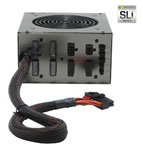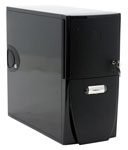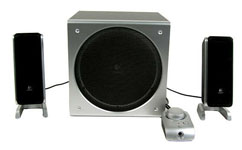Mid-Range Buyer's Guide, September 2005
by Jarred Walton on September 19, 2005 12:05 AM EST- Posted in
- Guides
Remaining Recommendations
We've covered the major components of the systems, and all that remains are the accessories. There isn't much new to say on the majority of these parts, and our Price Guides cover each area in more detail. Here are the rest of the components, and for most of them personal preference will play a large part in determining what you get. If you want higher quality speakers, you'll need to spend more money. A faster hard drive (or multiple hard drives) is definitely an option, but for most people it won't have a major impact - we generally prefer storage capacity and low noise levels over a small increase in HDD performance. Case, power supply, and optical storage choices round out the final components.
We have two lists of the remaining parts, one for the gaming configurations and the other for the office setups. We tried to balance the final system cost as much as possible, but the simple truth is that a good gaming/enthusiast setup requires more expensive parts than a business configuration. You can always downgrade some of the components to cheaper alternatives, but if we were building a computer for our own use, we'd rather save up for better quality than settle for lower cost.
Gaming Components:
Office Components:
Most of the choices should be pretty self-explanatory, so we just want to touch on the important areas. First, we've chosen to use a higher end power supply for the gaming configuration. Many people think that the modular power supplies are nice as they help to eliminate cable clutter, though some of the cables are a little stiff and can be difficult to route. The SunBeam 550W that we've chosen includes two PCIe power connectors, which would be required for an SLI configuration. (If you're running high-end components in an SLI setup, we'd think twice about using simple molex-to-PCIe adapters.) $86 for a power supply is a lot of money, but that's better than having random system crashes caused by exceeding the PSU load levels. Antec, OCZ, Enermax, and a few others also have some SLI-ready power supplies, though most cost upwards of $100 (and we'd avoid anything claiming SLI readiness that costs under $75).
Both setups use pretty low-end speaker arrangements. The Z-3e speakers sound good for the price, but they're not at the level of something like the Z-5500 or Klipsch, and true audiophiles would scoff at either of those "high end" choices that we just mentioned. If you're serious about audio quality, you probably already know more than what we typically cover in the Buyer's Guides. (The entire Logitech line of speakers is pretty reasonable if you're looking for other options. We've recommended them many times in the past, and this isn't really a change in recommendation so much as an alternative that you might consider.) We also stick with the integrated audio solutions for all of the systems, though the Karajan adapter of the DFI board certainly offers the best overall quality of the four boards. While there is a difference between integrated audio and discrete audio solutions, you'll need better speakers before it really begins to matter.
Our hard drive and optical drive selections are essentially a toss up. Our last Hard Drive Roundup showed that SATA 3.0Gbps drives were faster in some areas, NCQ could help out in certain tests as well, but there was no clear victor. All things being equal, we'll go for cost per GB, and for the dual-core systems, we'll also grab an NCQ enabled drive. Some people would rather have a better warranty like the 5-year Seagate and Western Digital Raptor or Caviar RE. If you ever need to use that warranty, though, you'll probably be pretty unhappy - the data on the drive is almost always more important than the drive itself. That's why a good backup strategy is important, and the DVDR drives that we've listed will get you started. We should also mention that firmware updates to the NEC 3540A and BenQ DW1640 drives have ironed out most of the media compatibility issues, so either drive is a good purchase.
We've covered the major components of the systems, and all that remains are the accessories. There isn't much new to say on the majority of these parts, and our Price Guides cover each area in more detail. Here are the rest of the components, and for most of them personal preference will play a large part in determining what you get. If you want higher quality speakers, you'll need to spend more money. A faster hard drive (or multiple hard drives) is definitely an option, but for most people it won't have a major impact - we generally prefer storage capacity and low noise levels over a small increase in HDD performance. Case, power supply, and optical storage choices round out the final components.
We have two lists of the remaining parts, one for the gaming configurations and the other for the office setups. We tried to balance the final system cost as much as possible, but the simple truth is that a good gaming/enthusiast setup requires more expensive parts than a business configuration. You can always downgrade some of the components to cheaper alternatives, but if we were building a computer for our own use, we'd rather save up for better quality than settle for lower cost.
 |
 |
 |
| Click images to enlarge. | ||
Gaming Components:
| Hard Drive: | Western Digital SATA II 160GB 7200RPM 8MB Caviar SE | $81 |
| Optical Drive: | BenQ DW1640 Black (OEM) | $43 |
| Case: | Cooler Master Cavalier 3 CAV-T03-UK | $76 |
| Power Supply: | SunBeam 550W NUUO SUNNU550-US-BK Modular PSU | $86 |
| Speakers: | Labtec ARENA 685 5.1 Speakers | $48 |
| Keyboard and Mouse: | Logitech Internet Pro Desktop | $23 |
 |
 |
 |
| Click images to enlarge. | ||
Office Components:
| Hard Drive: | Hitachi SATA 250GB 7200RPM 8MB Deskstar 7K250 NCQ | $120 |
| Optical Drive: | NEC 3540A Black (OEM) | $42 |
| Case and Power Supply: | Antec Sonata II + SmartPower 2.0 450W PSU | $115 |
| Speakers: | Logitech Z-3e 2.1 Speakers | $73 |
| Keyboard and Mouse: | Logitech Internet Pro Desktop | $23 |
Most of the choices should be pretty self-explanatory, so we just want to touch on the important areas. First, we've chosen to use a higher end power supply for the gaming configuration. Many people think that the modular power supplies are nice as they help to eliminate cable clutter, though some of the cables are a little stiff and can be difficult to route. The SunBeam 550W that we've chosen includes two PCIe power connectors, which would be required for an SLI configuration. (If you're running high-end components in an SLI setup, we'd think twice about using simple molex-to-PCIe adapters.) $86 for a power supply is a lot of money, but that's better than having random system crashes caused by exceeding the PSU load levels. Antec, OCZ, Enermax, and a few others also have some SLI-ready power supplies, though most cost upwards of $100 (and we'd avoid anything claiming SLI readiness that costs under $75).
Both setups use pretty low-end speaker arrangements. The Z-3e speakers sound good for the price, but they're not at the level of something like the Z-5500 or Klipsch, and true audiophiles would scoff at either of those "high end" choices that we just mentioned. If you're serious about audio quality, you probably already know more than what we typically cover in the Buyer's Guides. (The entire Logitech line of speakers is pretty reasonable if you're looking for other options. We've recommended them many times in the past, and this isn't really a change in recommendation so much as an alternative that you might consider.) We also stick with the integrated audio solutions for all of the systems, though the Karajan adapter of the DFI board certainly offers the best overall quality of the four boards. While there is a difference between integrated audio and discrete audio solutions, you'll need better speakers before it really begins to matter.
Our hard drive and optical drive selections are essentially a toss up. Our last Hard Drive Roundup showed that SATA 3.0Gbps drives were faster in some areas, NCQ could help out in certain tests as well, but there was no clear victor. All things being equal, we'll go for cost per GB, and for the dual-core systems, we'll also grab an NCQ enabled drive. Some people would rather have a better warranty like the 5-year Seagate and Western Digital Raptor or Caviar RE. If you ever need to use that warranty, though, you'll probably be pretty unhappy - the data on the drive is almost always more important than the drive itself. That's why a good backup strategy is important, and the DVDR drives that we've listed will get you started. We should also mention that firmware updates to the NEC 3540A and BenQ DW1640 drives have ironed out most of the media compatibility issues, so either drive is a good purchase.










56 Comments
View All Comments
plinden - Monday, September 19, 2005 - link
Point to a console game that can compete with Civilization III. (Imagine trying to control such a game without a mouse....)Civ III plays nicely on my three yr old 1.8GHz, as does Age of Empires and Sim City IV. You don't need a $1500 gaming PC with a $380 GPU to play Civ III or any other strategy/sim game (ok, that's currently - but I doubt even Civ IV will be that resource hungry)
(You can tell from the games in my collection when I was last able to spend any time playing games)
bob661 - Monday, September 19, 2005 - link
I don't think he was refering to the hardware. Rather, the existence of a similiar game for the console.Pete84 - Monday, September 19, 2005 - link
You need friends to play games with on the sofa, otherwise a PC is much better. I live in the sticks so the multiplayer capabilities of consoles doesn't do much, my hasn't figured out a gamepad yet :pPythias - Monday, September 19, 2005 - link
Good job, although it seems to me that you seem almost apologetic about some of your choices. Dont be. If folks want to complain about your choices, let them write their own damned guide. :)Methusela - Monday, September 19, 2005 - link
I'm pretty impressed, overall, by the guide. I read through the whole thing and can't really find more than minor faults with any part of it. Those don't even really beg mentioning except for not including the price of an OS with it. You're not going to do much gaming without Winblows, I'm sad to report. Even office applications and accounting packages rarely come compatible with *nix unless they're enterprise-class.It's an interesting comparison given that I've purchased some reasonably mid-range PCs for my office from a local white box shop. The prices (and componentry) here compare favorably to what they were charging, except that you don't get any overall system warranties with the DIY systems listed here. Overall, though, I'd probably prefer to build my own at work if my boss would allow. Building affords you many extra benefits and prevents any corner-cutting that you don't decide upon directly.
Thanks, Jarred!
JarredWalton - Monday, September 19, 2005 - link
Yeah, I cheat on the non-inclusion of the OS. Personally, I'd grab XP Pro, so add about $135 to each system - unless you have a copy of XP Pro that you want to remove from another PC, I suppose.